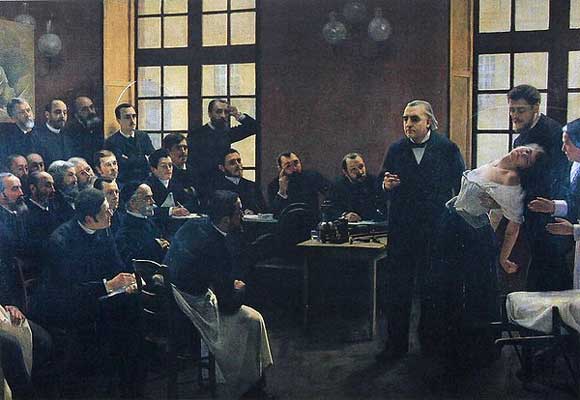
André Brouillet illustration of “Une leçon clinique à la Salpêtrière.” Shown are several famous physicians of the time, Gilles de la Tourette (wearing the apron), Pierre Marie (seated third on the right), Babinski (supporting the patient), and Charcot (demonstrating the effects of hypnosis on one of his “grandes hysteriques”).
Perhaps no other physician in history has been associated with more diseases than Jean-Martin Charcot (1825-1893). He was one of the greatest neurologists of the 19th century, instrumental in developing the systematic neurological examination based on correlating clinical features observed during life with changes found at autopsy.
At the Salpêtrière, the large hospital and asylum in Paris, Charcot made major contributions to the understanding of multiple sclerosis, motor neuron disease, Parkinson’s disease, epilepsy, stroke, and neurosyphilis. The many diseases or syndromes eponymously named after him include Charcot–Marie–Tooth disease (peroneal muscular atrophy); Charcot’s triad for diagnosing multiple sclerosis; Charcot-Bouchard cerebral aneurysms; Charcot’s visual agnosia; also the deformed Charcot’s joints in patients with lower extremity sensory loss; Charcot–Leyden crystals in allergic diseases; Charcot’s triad (jaundice; fever, and upper quadrant abdominal pain) and Charcot’s intermittent fever in liver disease; and Charcot’s post-tussive syncope (after paroxysmal coughing).
In his comments on anorexia nervosa, Charcot mentioned that convincing a patient to resume eating requires a physician with a dominant personality, which he clearly appears to have had. He vigorously propounded his theories about hysteria, believing it was a neurological disorder characterized by the ability to be hypnotized. His clinical demonstrations at the Salpêtrière were famous and attended by all fashionable Parisians. Axel Munthe, in his semi-biographical book (The Story of San Michele) presents a less flattering picture, describing these sessions as staged events, “a hopeless muddle of truth and cheating,” claiming that young street girls were trained or highly suggested to simulate convulsions, catatonia, crawl on the floor and bark like dogs, flap their arms like pigeons, eat charcoal presented to them as chocolate, or spend their days in a state of semi-trance. Munthe at the time was studying medicine in Paris, and some later writers have challenged the veracity of his account.

Leave a Reply